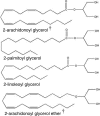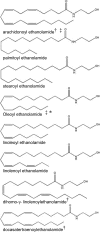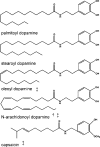The expanding field of cannabimimetic and related lipid mediators
- PMID: 15655504
- PMCID: PMC1576036
- DOI: 10.1038/sj.bjp.0706093
The expanding field of cannabimimetic and related lipid mediators
Abstract
The discovery of the endogenous cannabimimetic lipid mediators, anandamide and 2-arachidonoyl glycerol, opened the door to the discovery of other endogenous lipid mediators similar in structure and function. The majority of these compounds do not bind appreciably to known cannabinoid receptors; yet some of them produce cannabimimetic effects while others exert actions through novel mechanisms that remain to be elucidated. This review explores the growing diversity of recently discovered putative lipid mediators and their relationship to the endogenous cannabinoid system. The possibility that there remain many unidentified signalling lipids coupled with the evidence that many of these yield bioactive metabolites due to actions of known enzymes (e.g. cyclooxygenases, lipoxygenases, cytochrome P450s) suggests the existence of a large and complex family of lipid mediators about which only little is known at this time. The elucidation of the biochemistry and pharmacology of these compounds may provide therapeutic targets for a variety of conditions including sleep dysfunction, eating disorders, cardiovascular disease, as well as inflammation and pain.
Figures





References
-
- AHERN G.P. Activation of TRPV1 by the satiety factor oleoylethanolamide. J. Biol. Chem. 2003;278:30429–30434. - PubMed
-
- BEN-SHABAT S., FRIDE E., SHESKIN T., TAMIRI T., RHEE M.H., VOGEL Z., BISOGNO T., DE PETROCELLIS L., DI MARZO V., MECHOULAM R. An entourage effect: inactive endogenous fatty acid glycerol esters enhance 2-arachidonoyl-glycerol cannabinoid activity. Eur. J. Pharmacol. 1998;353:23–31. - PubMed
-
- BERDYSHEV E.V. Inhibition of sea urchin fertilization by fatty acid ethanolamides and cannabinoids. Comp. Biochem. Physiol. C Pharmacol. Toxicol. Endocrinol. 1999;122:327–330. - PubMed
-
- BISOGNO T., VENTRIGLIA M., MILONE A., MOSCA M., CIMINO G., DI MARZO V. Occurrence and metabolism of anandamide and related acyl-ethanolamides in ovaries of the sea urchin Paracentrotus lividus. Biochim. Biophys. Acta. 1997;1345:338–348. - PubMed
-
- BOGER D.L., HENRIKSEN S.J., CRAVATT B.F. Oleamide: an endogenous sleep-inducing lipid and prototypical member of a new class of biological signaling molecules. Curr. Pharm. Des. 1998a;4:303–314. - PubMed
Publication types
MeSH terms
Substances
Grants and funding
LinkOut - more resources
Full Text Sources
Other Literature Sources

